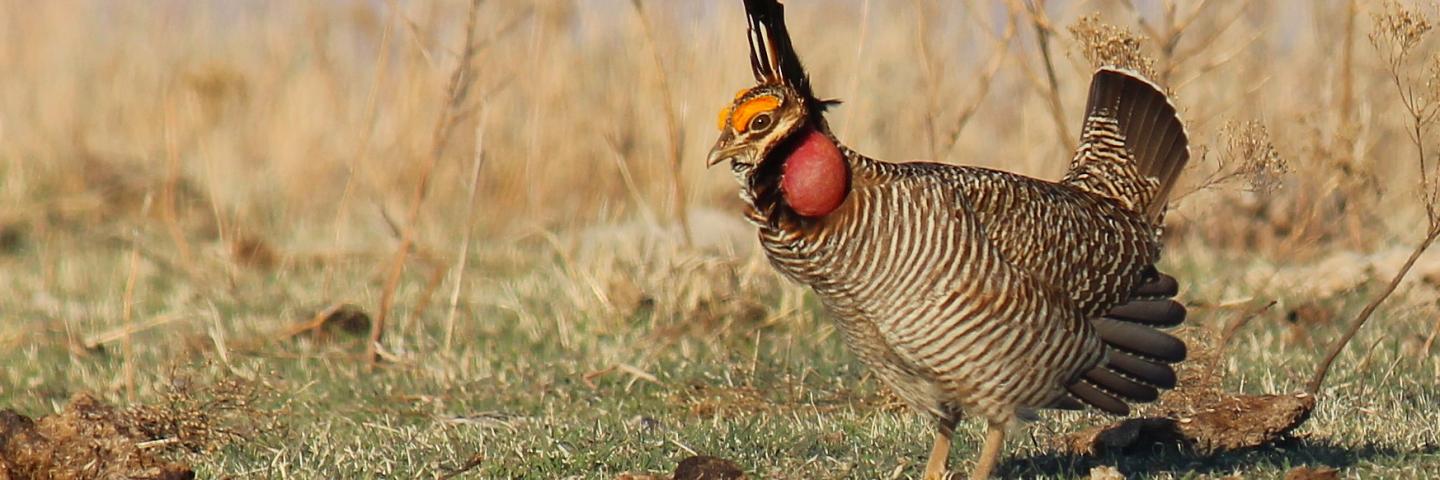
News

Best known for their dramatic courtship display, the lesser prairie chicken depends on prairie and grassland ecosystems that have evolved under the interaction of fire and large herbivore grazing over the years.
Best known for their dramatic courtship display, the bird depends on prairie and grassland ecosystems that have evolved under the interaction of fire and large herbivore grazing over the years.
Primarily due to large-scale loss of habitat and fragmentation of habitat, their range distribution has been reduced by roughly 85 percent. About 95 percent of the lesser prairie chicken’s habitat is privately owned, making the land management decisions of producers pivotal to the bird’s success. Stewardship-minded producers are helping the at-risk bird and many other wildlife species by voluntarily improving the health of prairie and grassland ecosystems.
Producers in Kansas, Oklahoma, New Mexico, Texas and Colorado are helping the lesser prairie-chicken rebound by voluntarily conserving habitat on their land.

NRCS offers technical and financial assistance to help agricultural producers to voluntarily conserve lesser prairie-chicken habitat on private lands. This assistance helps producers plan and implement a variety of conservation activities, or practices, that benefit the bird and agricultural operations.
Technical assistance is free to producers, through which the agency’s conservationists work side-by-side with producers to develop a conservation plan. This plan is customized the producer’s land and provides a roadmap for how to use a system of conservation practices to meet natural resource and production goals.
Financial assistance helps producers pay for the adoption of a system of conservation practices that improve the health of prairie and grassland ecosystems. NRCS assistance covers part of the cost. Common conservation practices for the lesser prairie-chicken include the removal of redcedar and mesquite and use of prescribed grazing and burning.
The lesser prairie-chicken is a nationally identified target species of the Working Lands for Wildlife (WLFW) partnership, a collaborative approach to conserve habitat while keeping working lands working. From 2010 to 2015, the Lesser Prairie-Chicken Initiative (part of the WLFW family) enabled producers to conserve more than 1 million acres of prime habitat.
Through WLFW, NRCS targets conservation efforts where the returns are highest by targeting threats to the bird. For the lesser prairie-chicken, the loss and fragmentation of habitat is caused by invading mesquite and redcedars, poor grassland and prairie health and conversion to cropland. WLFW is able to provide technical and financial assistance through the Environmental Quality Incentives Program and Agricultural Conservation Easement Program, two programs funded through the Farm Bill.
Lesser Prairie-Chicken Initiative’s website
Contact your local service center to start your application.
Do you farm or ranch and want to make improvements to the land that you own or lease?
Natural Resources Conservation Service offers technical and financial assistance to help farmers, ranchers and forest landowners.

To get started with NRCS, we recommend you stop by your local NRCS field office. We’ll discuss your vision for your land.
NRCS provides landowners with free technical assistance, or advice, for their land. Common technical assistance includes: resource assessment, practice design and resource monitoring. Your conservation planner will help you determine if financial assistance is right for you.
We’ll walk you through the application process. To get started on applying for financial assistance, we’ll work with you:
Once complete, we’ll work with you on the application, or CPA 1200.
Applications for most programs are accepted on a continuous basis, but they’re considered for funding in different ranking periods. Be sure to ask your local NRCS district conservationist about the deadline for the ranking period to ensure you turn in your application in time.
As part of the application process, we’ll check to see if you are eligible. To do this, you’ll need to bring:
If you don’t have a farm number, you can get one from USDA’s Farm Service Agency. Typically, the local FSA office is located in the same building as the local NRCS office. You only need a farm number if you’re interested in financial assistance.
NRCS will take a look at the applications and rank them according to local resource concerns, the amount of conservation benefits the work will provide and the needs of applicants. View Application Ranking Dates by State.
If you’re selected, you can choose whether to sign the contract for the work to be done.
Once you sign the contract, you’ll be provided standards and specifications for completing the practice or practices, and then you will have a specified amount of time to implement. Once the work is implemented and inspected, you’ll be paid the rate of compensation for the work if it meets NRCS standards and specifications.